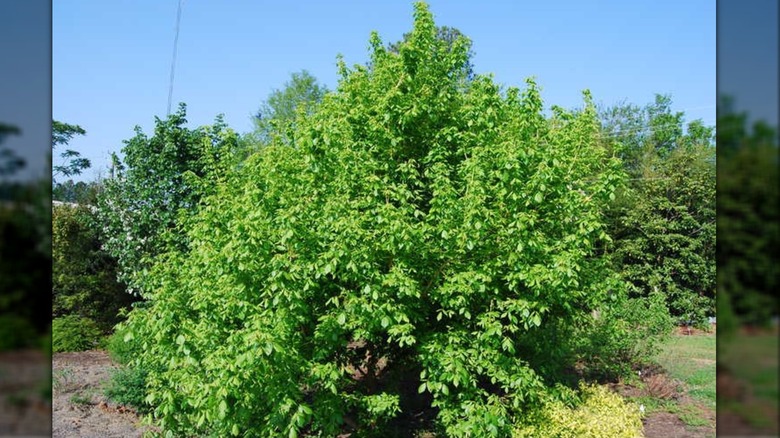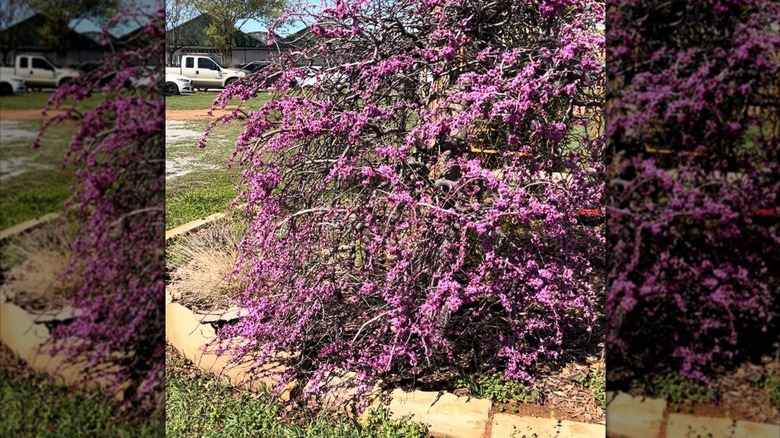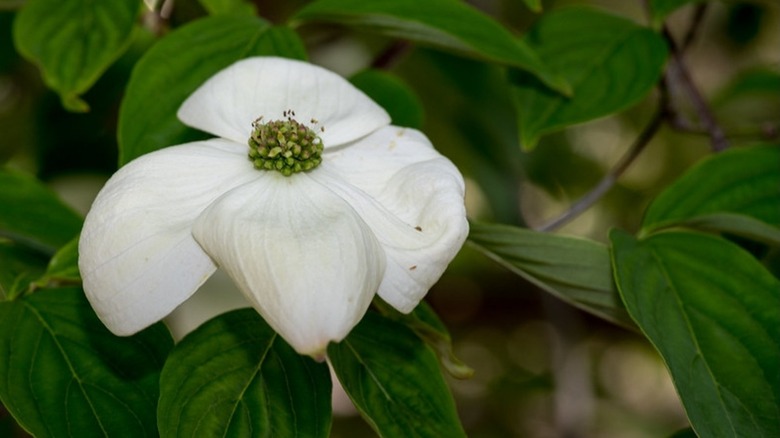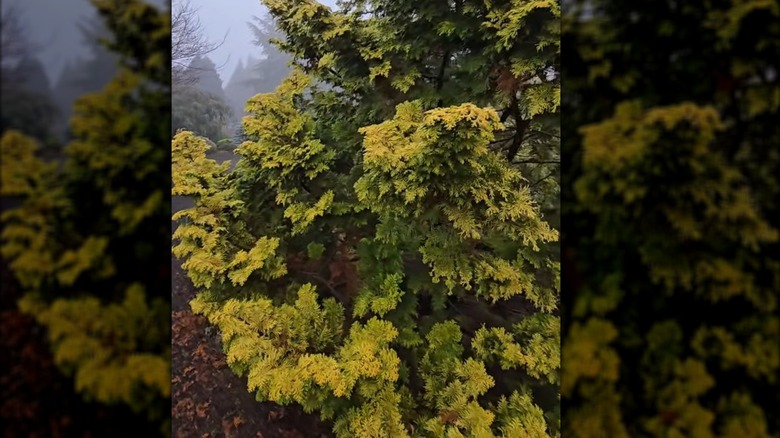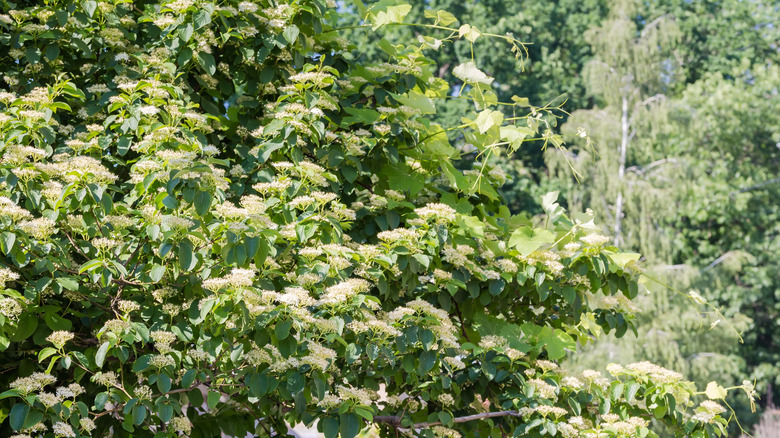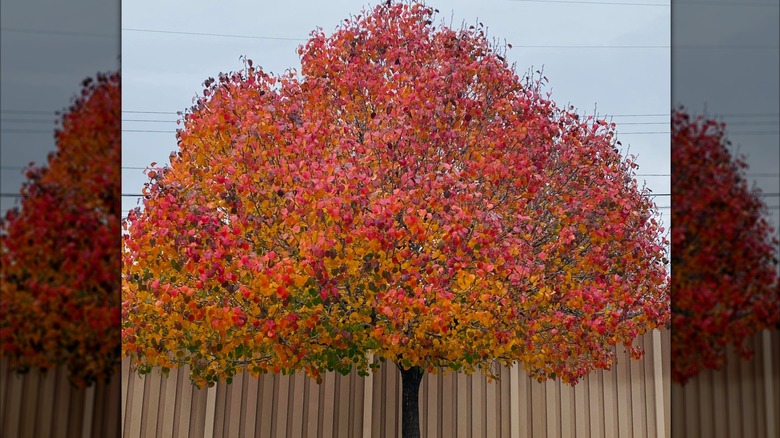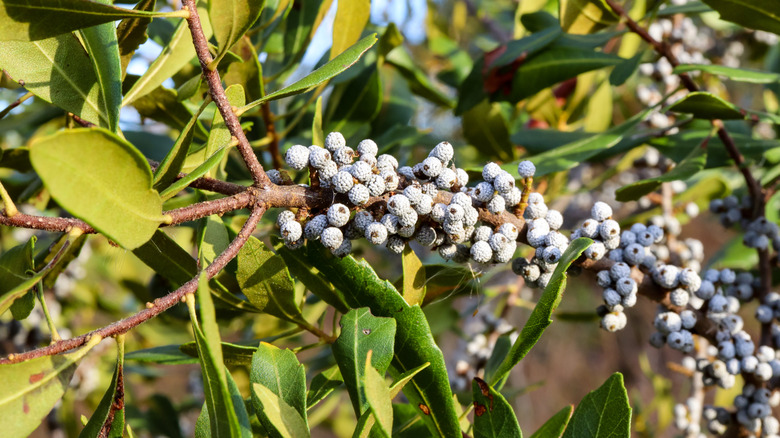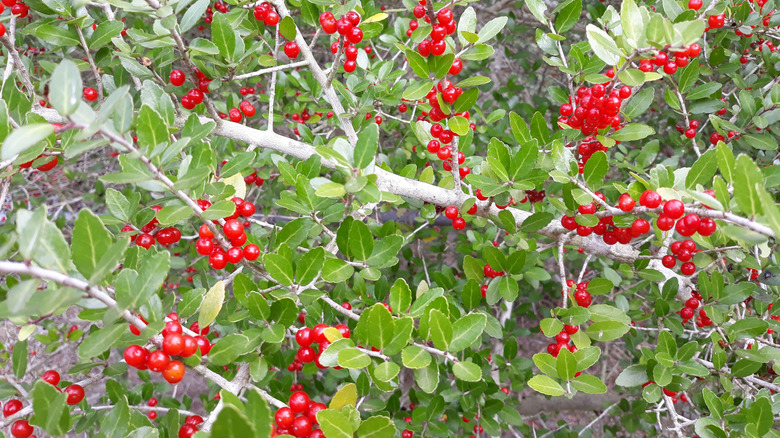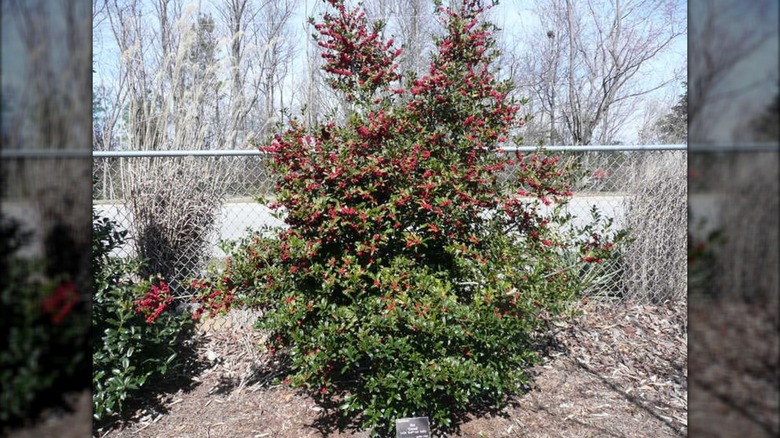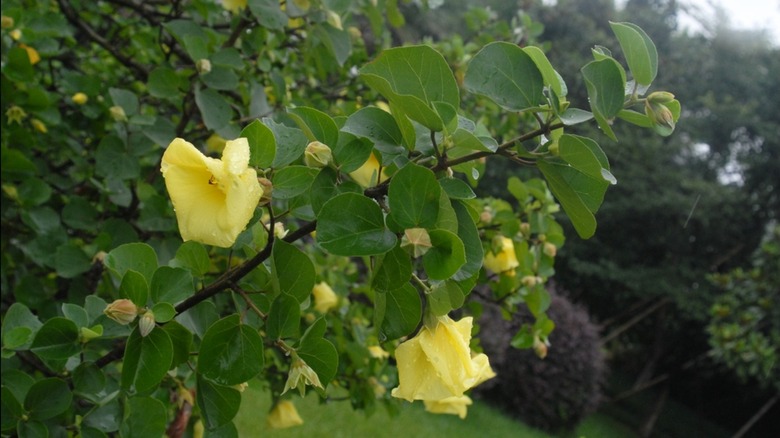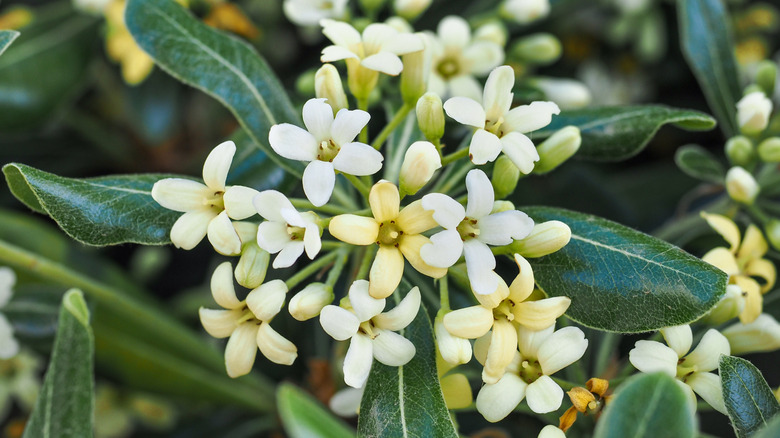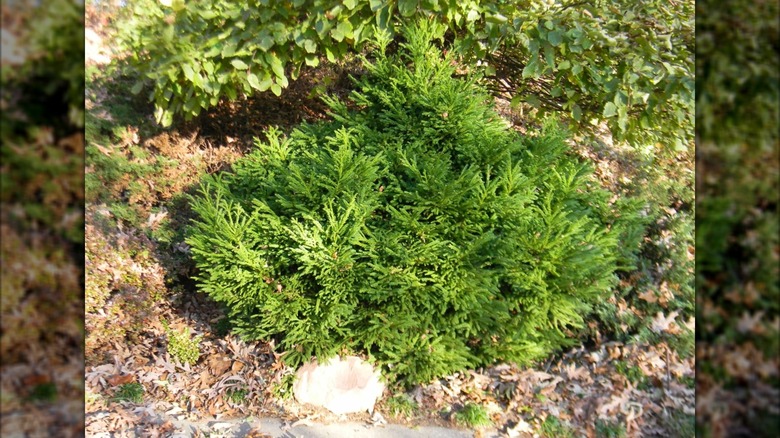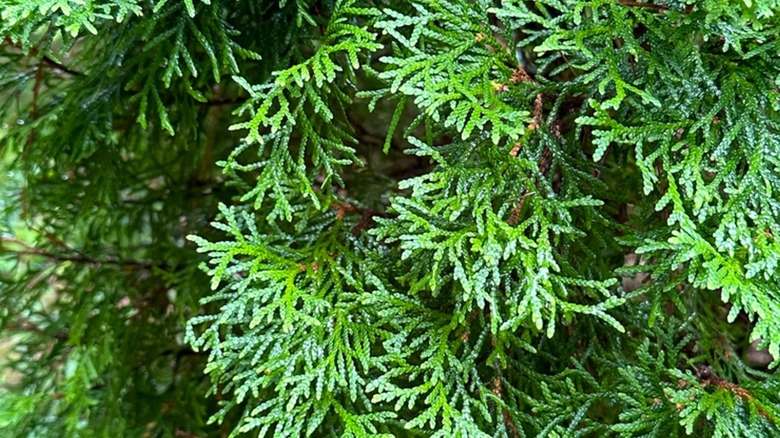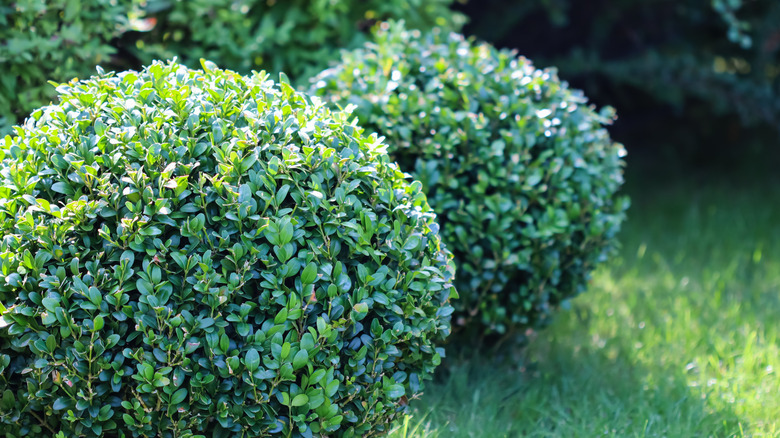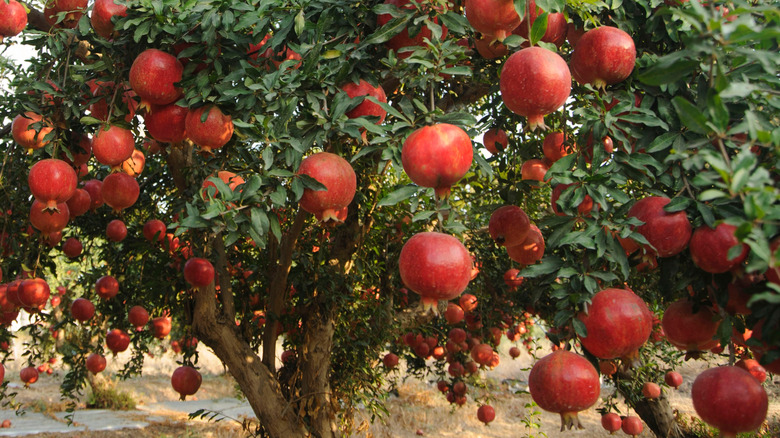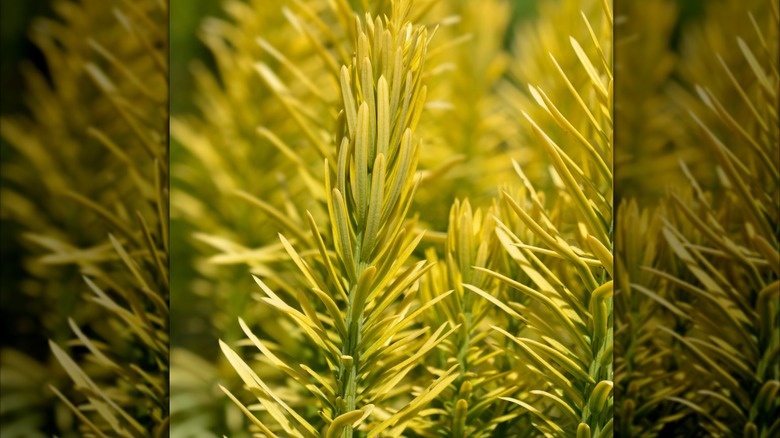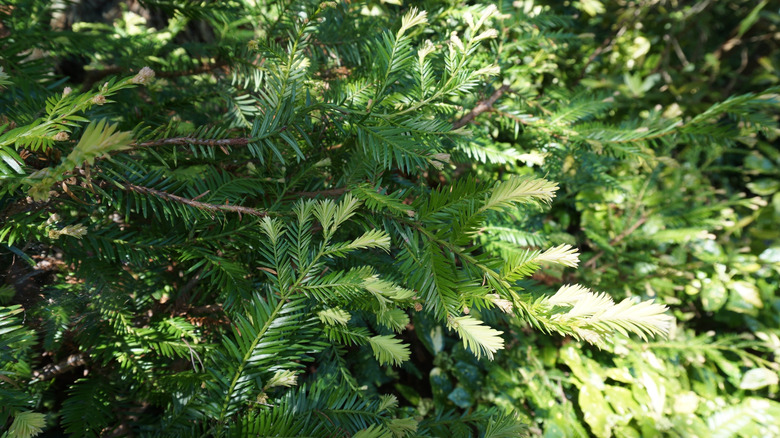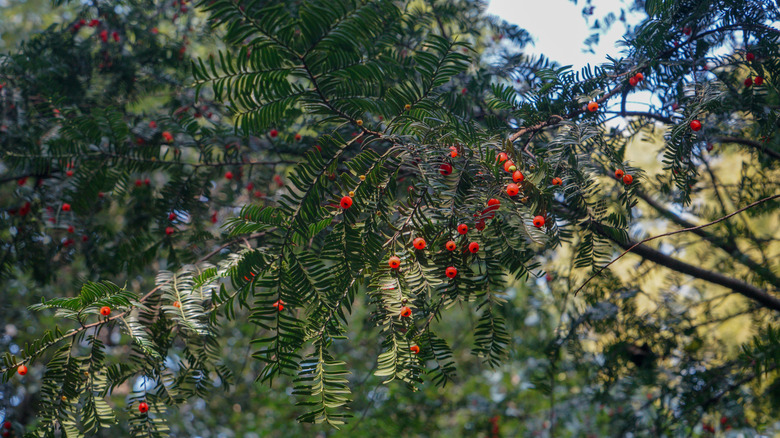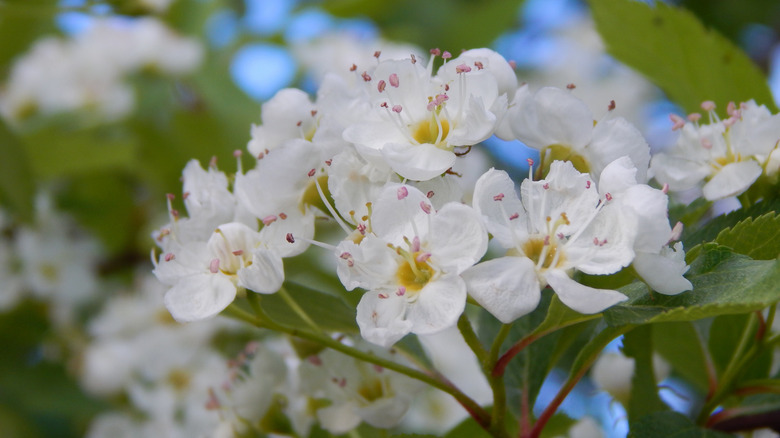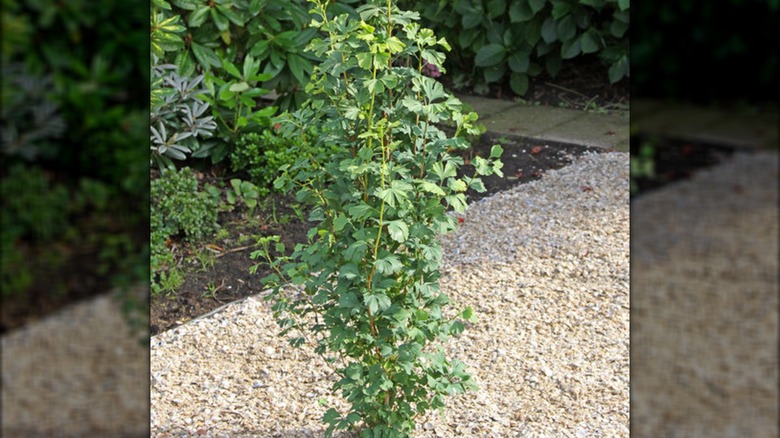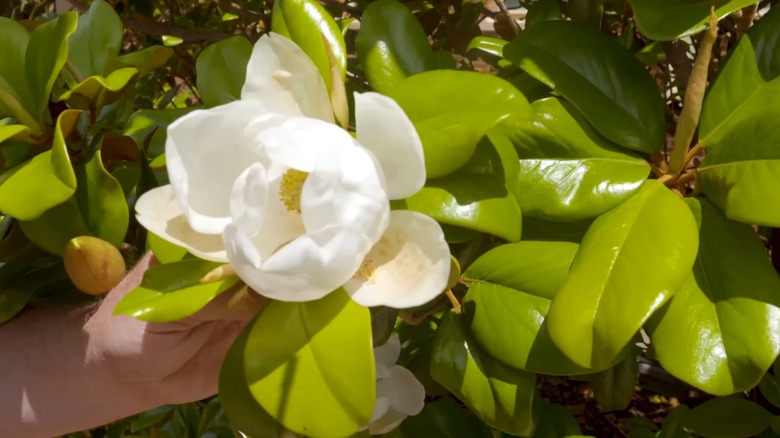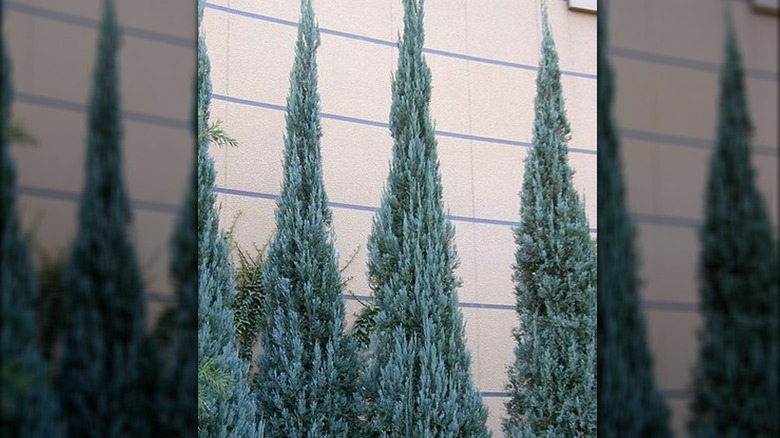The 27 Best Trees To Plant For Privacy If You Have A Smaller Backyard
With new homes shrinking in size while the neighborhoods become denser, the need for privacy has never been more pressing. But with backyards growing modest in tandem, traditional favorites like mighty oaks, weeping willows, or Leyland cypress can no longer be tapped into for living fences. Instead, you must frame your yards with compact plantings that scale down to the limited area while still being sufficiently dense to keep prying eyes out. Importantly, these trees must also mature under 25 feet to avoid utility line conflicts.
Fortunately, numerous small trees, such as pagoda dogwood, smoketree, wax myrtle, yaupon holly, and hibiscus hamabo, offer gorgeous privacy solutions for space-restrained yards without overwhelming. Even taller favorites like redbuds, cedars, dogwoods, hollies, and arborvitae have compact cultivars that provide similar benefits at a fraction of the size. All you have to do is take stock of the site's conditions, like sun exposure, soil quality, drainage, and pest concerns, and find the tree that best matches them from the curated list that follows below. Aim to plant your selection in odd clusters so the screen appears natural. Wherever possible, deploy mixed plantings so that you won't have a total screen loss over a pest outbreak. Ready? Here are some of the best trees to plant for privacy in small backyards.
'Winter Lightning' boxelder maple
Also known as yellow-twigged box elder, 'Winter Lightning' boxelder maple (Acer negundo 'Winter Lightning') is an exceptionally cold-hardy deciduous tree that can grow in all U.S. states, save for Alaska and Hawaii. Its main highlights include yellow twigs that look beautiful draped in snow flurries, bee-attracting spring flowers, and bronze fall colors. Usually, 'Winter Lightning' establishes as a multi-stemmed shrubby tree, though if you're ready to put in some work, it can be trained into a single-trunk. Since it's a fast grower, it will recover quickly. For a privacy screen, space them 15 feet apart.
'Ruby Falls' redbud
Where deer don't maintain a fearful presence, consider growing 'Ruby Falls' redbud (Cercis canadensis 'Ruby Falls'). Since this tree is low maintenance, it can put down roots in all kinds of soils, including clay and alkaline. Plus, it attracts little attention from the usual garden pests. Since it grows about 4 feet wide and 6 feet up, 'Ruby Falls' can be nestled in the smallest spaces, and mass planted to achieve the desired screen size. You, along with a myriad of bees, butterflies, and hummingbirds, will likely appreciate its pea-shaped rosy flowers that bloom during spring. Their heart-like, maroon foliage is equally attractive.
'Traveller' weeping Texas redbud
'Traveller' weeping Texas redbud (Cercis canadensis subsp. texensis 'Traveller') has a lot to offer. When you need a sign that spring is here, it will let you know first-hand by exploding into wisps of lavender blooms, in turn, enticing many pollinators. Since its branches tastefully droop down in a rounded arch, the multi-stemmed tree adds huge textural interest to your privacy. However, this also implies that 'Traveller' grows wider than tall and so it'd be inappropriate in narrow spaces. Grow it in full-to-part sun in alkaline or neutral soils. It's drought-tolerant and is deer-resistant.
'Stellar Pink' dogwood
Hybridized by Dr. Orton from Rutgers University, 'Stellar Pink' dogwood (Cornus x rutgersensis 'Rutgan') outmatches standard dogwood species because it exhibits superior resistance to anthracnose and borers. Although the deciduous tree is sterile, it's a show-stopper nonetheless, blushing pink when it's springtime while its dense foliage turns purplish-red for fall. 'Stellar Pink' is a rapid grower and can mature upwards of 20 feet. Despite being hardy in zones 5 through 9, this dogwood cultivar must be mulched in hot summers to keep its roots cool. If maintaining a formal screen, prune it in winter to tidy its pyramidal form.
Yellow hinoki cypress
Do you live in a humid environment? Then, yellow hinoki cypress (Chamaecyparis obtusa 'Confucius') might suit your requirements. For starters, it grows over 6 feet tall and just as wide. So, it can easily be planted en-masse in small backyards for privacy. It's unfussy about soil texture, acidity, and drainage, tolerating diverse conditions, although moist, fine-draining mediums are preferred. Since it's a needled evergreen tree, yellow hinoki cypress will render year-round interest, looking particularly ornate when its pollen-bearing red cones suspend from needled tips. Wildlife may turn its foliage into its winter habitat. Site it in full-to-part sun exposure.
Pagoda dogwood
Are you looking for small trees that add color to your landscape without damaging your home or driveway? Look no further than pagoda dogwood (Cornus alternifolia). Apart from rendering four-season interest through its creamy-white flowers and winter-persisting bluish-black fruits, pagoda dogwood adds a Zen-like touch to the yard with its tiered form, as its namesake "pagoda" suggests. Typical specimens top out at 25 feet, though they stretch out far wider. But if they're too big for your space, shorter cultivars like 'Bachone' (horticulturally sold as "Gold Bullion") are available. Optimal growth conditions require moist soils in a partially shaded, wind-protected spot.
American smoketree
Giving most native trees a run for color, American smoketree (Cotinus obovatus) is sure to get your neighbors talking when it puffs out clouds of pink threads after flowering in summer. Although it grows slowly, this deer-resistant tree can mature to heights of 30 feet. Pruning in late winter can help keep its size manageable in tiny yards, but wear gloves as its sap contains urushiol — an irritant common to poison ivy. You may have to occasionally clip off lower limbs for ground clearance. Smoketree fares best in full sun and exhibits tolerance to soil alkalinity and compaction.
Wax myrtle
You can plant fast-growing wax myrtle trees in your yard for a low-maintenance privacy screen even if all they'll ever receive is dry shade. However, make sure it's sited beyond your home's defensible zone because the plant parts contain flammable compounds. Botanically named Myrica cerifera, wax myrtle is an interesting specimen that tolerates both flooded and drought-stressed conditions after establishment. But to get it to such an easy-care position, you must water it generously during the planting stage. Hardy through zone 7, this wind-resistant tree will defoliate for below-zero-degree temperatures. It's popular with butterflies and birds, but not deer.
'Kay Parris' magnolia
When year-round privacy is paramount, grow 'Kay Parris' magnolia (Magnolia grandiflora 'Kay Parris'), an evergreen with dense, glossy foliage. 'Kay Parris' distinguishes itself from other magnolia cultivars through the burnished-orange hues present on its undersides. From summer through autumn, these magnolia trees bloom pretty white flowers that may be small but smell oh-so-divine. Give them full sun and good drainage, although they'll tolerate wet soils. As 'Kay Parris' grows taller than wide, spanning 10 feet by maturity, it can fit in narrow spaces. Hardy through zone 6, it can bear ice without taking significant damage.
'Genie' magnolia
Another magnolia cultivar that's appropriate for postage stamp-sized yards is 'Genie' magnolia (Magnolia x 'Genie'). It displays a 5-foot-wide pyramidal form, topping out at 13 feet. Unlike 'Kay Parris', 'Genie' grows best in a sheltered site, far away from wind exposure. Also, its flowering season begins early in spring, where purplish-maroon buds unfurl into fragrant pink petals. If watered well, it may produce another flush in late summer. For a more formal look, trim its foliage every year after the flowers terminate. 'Genie' performs best in moist, rich soils with low pH levels. Full or partial sun is optimal.
Yaupon holly
Yaupon hollies (Ilex vomitoria) are fast-growing trees that will thrive in damp soil, apart from clay and sand. They're highly adaptable, growing on the entire spectrum from deep shade to full sun. However, you must maximize light exposure if you desire a thick canopy. Since yaupon hollies lack the characteristic thorns, they can be easily trimmed into privacy screens, though their vasiform habit can take a decade to develop. Alternatively, you may grow cultivars with weeping branches like 'Folsom's Weeping' or 'Pendula'. Since yaupon hollies sucker, you'll need to trim them occasionally unless you don't mind their colonization.
Oakleaf holly
If you don't mind spines — after all, such screens can double up as barriers — look into 'Conaf' holly (Ilex Oakleaf 'Conaf'), or oakleaf holly, as it's called in the trade. 'Conaf' will keep your backyard interesting because it starts as a pyramidal mass of reddish-bronze oak-shaped leaves that turn emerald green as the season warms. Since they bloom perfect flowers (meaning they don't require a separate pollinator), they also set orangish-red fruits that will have your yard ringing out bird songs. Oakleaf holly can extend over 8 feet across by maturity and must be pruned annually for a neat growth habit.
Hardy yellow hibiscus
An Asian native, albeit non-invasive, hardy yellow hibiscus (Hibiscus hamabo) is another beautiful tree you can plant in rows for privacy. Due to its salt tolerance, it might make a good fit in coastal locations. Although hardier than other hibiscus varieties, yellow hibiscus can suffer winter die-back in cool climates. Given that, it's best utilized in warmer ranges of its adaptive zones, which run from 8 through 12. With golden-orange flowers flushing out from spring through fall, these drought-resistant trees will keep your yard animated with hummingbirds and butterflies. You'll need to trim their foliage for bushier growth.
Japanese pittosporum
Japanese pittosporum (Pittosporum tobira) is one of the best hedges you can plant for privacy in your yard, especially in sandy coastal sites where salt and heat are imposing problems. It has incredibly dense, leathery foliage that can extend over 4 feet wide — rapidly at that. However, you'll need to shave off lower limbs to shape the fragrant specimen into a multi-trunked tree, which can make it high maintenance. But care levels will come down as growth rates moderate. As Japanese pittosporums' roots are quick to rot, avoid planting them in poorly draining sites or where roof gutters vent out.
'Magic Dragon' cedar
Those with little patience should consider growing 'Magic Dragon' cedar (Cryptomeria japonica 'Magic Dragon'). As they grow nearly 18 inches annually, even young trees will rapidly reach great heights and develop a dense screen. However, don't take this as a cue to cheap out on plants, as they rarely root from cuttings. In short, leave propagation to the nurseries. 'Magic Dragon' can be useful if you're keen on turning your yard and garden into a bird haven, as many birds like their layered branches for nesting and cover. Expose these needled evergreens to at least six hours of direct sunlight.
Sapphireberry
For an easy-care privacy screen that rabbits will usually ignore, consider saphireberry or Asiatic sweetleaf (Symplocos paniculata). It typically has a spreading habit, extending over 10 feet wide and tall, and can withstand wind action. Although you can leave it unpruned, the deciduous tree will eventually grow twiggy, so to keep it shapely, prune it minimally in late winter. That being said, if you're interested in encouraging the tree to set blue berries and keep your backyard birds sorted through fall and winter, plant at least three such trees to ensure adequate cross-fertilization. Please note that saphireberry is invasive in Maine.
'Degroot's Spire' arborvitae
When you've got a bog for a yard, use 'Degroot's Spire' arborvitae (Thuja occidentalis 'Degroot's Spire') as an evergreen screen. This is because it absolutely thrives in moist, organically-rich soils (even in low-lying areas). It has a beautiful pyramidal, albeit slender form that stands about 20 feet tall and 4 feet wide, at maturity. But if your conditions are relatively drier, keep the trees' roots mulched in the summer heat and site them so they're protected from drying winds (wherever possible). Paired with smoketree, 'Degroot's Spire' can make a lovely mixed-screen. Wear gloves before touching their leaves to avoid skin irritation.
Chinese fighazel
Chinese fighazel (Sycopsis sinensis) is another low-maintenance, easy-care contender for an evergreen screen. Pests and diseases usually don't pose any problems. Plus, the trees don't fuss over soils being clay-like or sandy. While the trees certainly bloom — profusely at that — they don't exactly scream spectacular because the golden flowers lack petals. However, they will still add some winter interest in an otherwise dreary landscape. Depending on your yard's size, either plant Chinese fighazel in multiples or a lone specimen, as it can grow over 10 feet wide and just as tall. Keep it fully or partially exposed to sunlight in zones 7 through 9.
Common box
In zones 5 through 8, you may grow common box (Buxus sempervirens) as an easy-maintenance, evergreen hedge. Besides blocking out peeping toms, it will also work its magic against deer and rabbits (unless they're famished). Box adapts to most soils from sand to clay, provided they drain well, although conditions like occasional flooding and drought stress are tolerated. Standard specimens can grow about 15 feet tall but can be sheared to the desired size. Otherwise, you may look into shorter cultivars like 'Fastigiata' or 'Dee Runk'. You'll have to monitor your hedge for boxwood blight, leafminers, and mites.
Pomegranate
Give your backyard privacy a fruity spin with pomegranate (Punica granatum) trees. Plus, they make a beautiful show of tubular flowers in sunset hues, attracting territorial hummingbirds for a heavenly drink between spring and fall. They tend to grow quite wide, nearly 8 feet or more, and slightly taller, so plan their site accordingly, lest they overwhelm the space. Despite being hardy in zones 8 to 10, pomegranate trees may not perform well in the southeast region because of the high humidity levels. Surprisingly, deer don't relish their foliage, although small mammals may compete with you for the fruits.
Japanese plum yew
Japanese plum yews (Cephalotaxus harringtonia) are another evergreen option for yards harassed by deer. They are also excellent in hot, yet deeply or partially shaded sites where common yews struggle — usually southeast U.S. to zone 6. In cool climates, they can take full sun. The needle-like leaves of Japanese plum yews are arranged like ferns, adding a textural touch to your backyard. Look for tree-like forms because they are usually sold as conifer shrubs. With regular pruning, which they respond well to, you can keep these evergreens under 8 to 10 feet tall.
Western yew
Hailing from the west U.S., western yew (Taxus brevifolia) is another shade-tolerant tree you can use for privacy. As it grows over 6 feet tall and half as wide, it can suitably fit in the smallest spaces. Since it grows as an understory tree in the wild, offering it partially shaded sites with moist soils will encourage the best growth. Otherwise, it will sprawl like a shrub. Western yew is easy to grow, including via seeds. Its red fruits play host to a variety of birds and moths. Unfortunately, its foliage is toxic to pets and attracts deer.
Chinese yew
By removing their lower limbs and exposing their peeling bark, Chinese yews (Taxus chinensis) can be trained into tree-like forms and planted in groups for an evergreen screen. Given their leafy texture, they can even pass for hemlocks. Fortunately, they don't grow as tall, terminating at about 10 feet. Since they bounce back from pruning, you can trim them shorter if needed. Space them about 6 to 8 feet apart in full-to-part sun. They're hardy through –10 degrees Fahrenheit and exhibit moderate drought and deer resistance. Their plant parts are toxic to children and pets upon ingestion.
Black hawthorn
Looking for trees to plant in your backyard for a bird-friendly winter habitat, erosion control, and privacy screen? Your search ends at black hawthorn (Crataegus douglasii). Cold hardy through southeast Alaska, it'll delight your backyard visitors with spring flowers and black fruits that may entail cleanup if they fail to hang on to their twigs during winter. Also, it requires full sun exposure and moist soils to showcase its best growth. Black hawthorn can grow over 10 feet tall and wide but can be pruned successfully into any desired shape. Be prepared to weed out suckers.
Skinny Fit ginkgo
Have only a square foot of space to spare? Try Skinny Fit ginkgo (Ginkgo biloba 'Menhir'). Its upright 3-foot-wide form will fit in the narrowest of backyards while its mature height of 15 feet will steer clear of utilities. Hardy in zones 4 through 9, Skinny Fit will make your landscape dramatic in the fall when it dons an overcoat of mustard yellow leaves, letting go of the typical greens. You must site in an area receiving six hours of direct sunlight in well-draining soils. Pruning isn't usually necessary as it holds its form. Please note that it may not flower.
Teddy Bear southern magnolia
In waterlogged or coastal sites, you may group multiple Teddy Bear southern magnolia (Magnolia grandiflora 'Southern Charm') trees for a slight red leafy touch to an otherwise green screen. By maturity, these evergreens can grow over 10 feet wide and 16 feet tall, so space them accordingly. They will need full sun if you're desirous of breathing in (or cutting) their aromatic white flowers that are in bloom from summer through fall. Fertile, acidic soils are equally important, though spreading organic mulch helps. Deer and rabbit usually avoid their foliage for meals.
'Blue Heaven' juniper
By planting several 'Blue Heaven' juniper (Juniperus scopulorum 'Blue Heaven') trees in rows, you can create an evergreen privacy that blocks winds and sounds in your small yard. These cultivars grow a pyramidal form of silverish-blue needles, measuring 10 feet up top and 5 feet across. Shallow rocky soils and alkaline pH levels are appreciated, as is full sun exposure. However, they'll accommodate poor soil conditions. If pollinated, 'Blue Heaven' bears beautiful blue cones. Avoid growing them in a hot, humid environment to stem disease pressure. Keep your hands gloved before handling junipers to avoid skin irritation.

